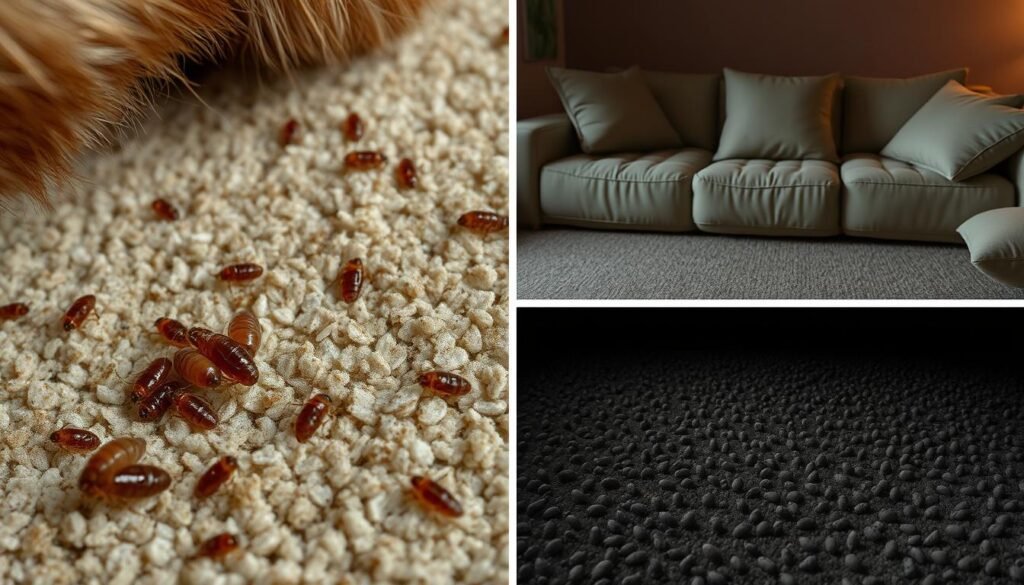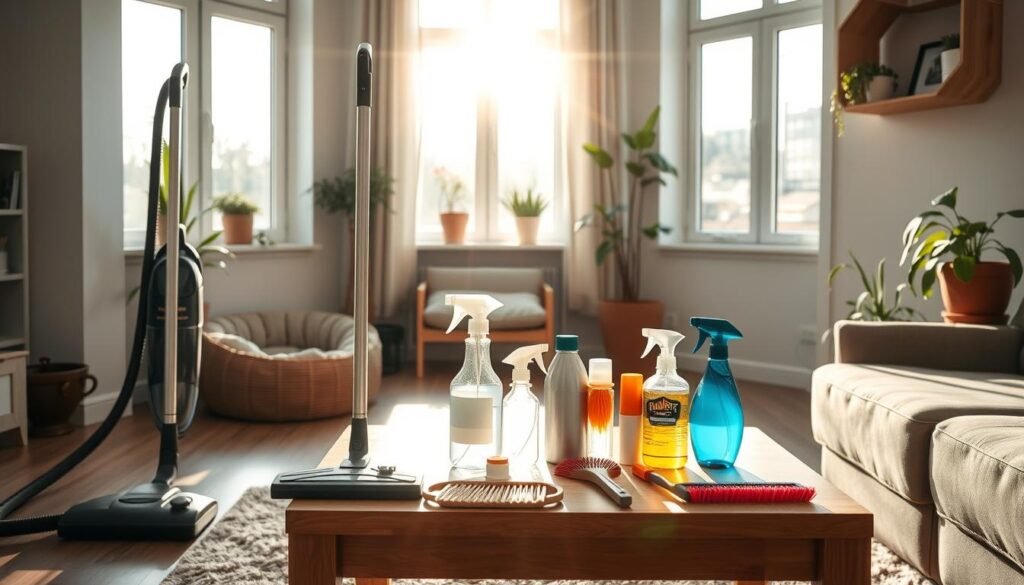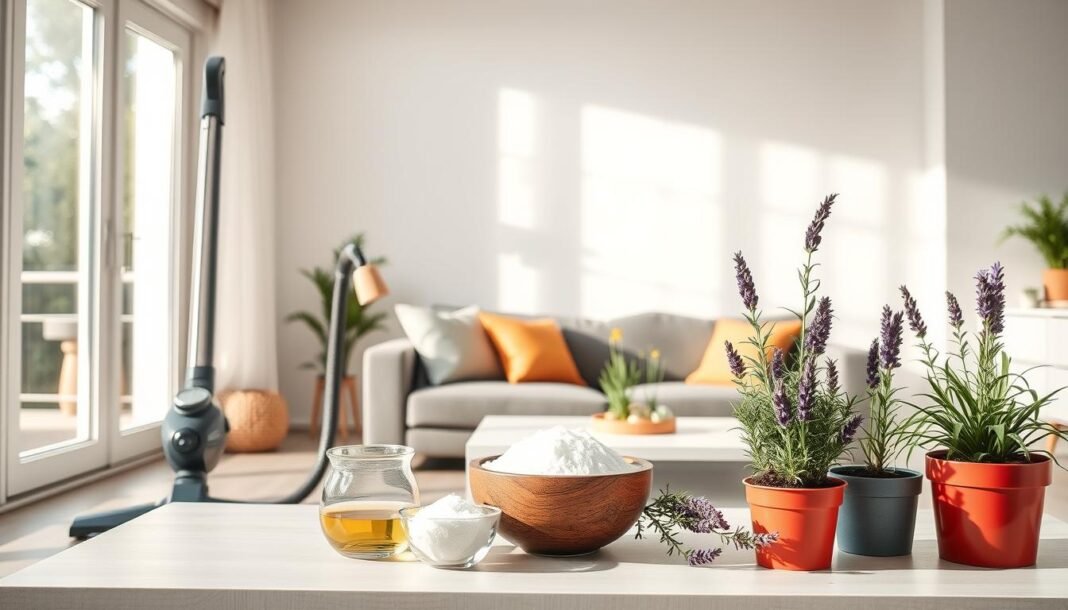Fleas cause stress and discomfort for pets and their humans. Getting rid of fleas is key for a healthy home. These small pests can lead to big problems if not handled correctly. This article gives top tips for safe and effective flea control. Learn how to make your home a comfortable place for everyone.
Key Takeaways
- Flea removal is essential for a healthy home environment.
- A comprehensive approach to flea treatment can prevent infestations.
- Pest management involves both home and pet care techniques.
- Regular pet grooming helps eliminate and prevent fleas.
- Understanding flea behavior is key to effective control strategies.
Understanding Fleas and Their Lifecycle
Fleas are small yet well-known parasites. They cause a lot of discomfort for pets and humans. Knowing about the flea lifecycle is key for getting rid of fleas effectively. It helps us spot and deal with flea problems early on.
The Different Stages of Fleas
The flea lifecycle has four stages: egg, larva, pupa, and adult. Each stage plays a role in the lifecycle. This makes it important to know how they affect pets and their environment. Flea eggs are laid on the host but then fall off. This can lead to infestations in our homes and yards.
In the larval stage, fleas feed on organic matter, like dead skin. This is often found in places like pet beds or carpets. The pupae stage is when fleas are in a cocoon, able to survive for weeks or even months. Finally, adult fleas emerge, seeking a host. They complete the lifecycle and keep the infestation going.
How Fleas Affect Pets and Humans
Fleas cause several problems for pets, from allergic reactions to skin irritations. This results in itching and discomfort. Pets might scratch a lot, leading to infections or loss of hair. Humans can also get bitten by fleas. These bites can turn into itchy, red spots on the skin. Sometimes, they cause more serious allergic reactions. That’s why controlling parasites is vital for the health of pets and humans alike.
Signs of a Flea Infestation
Spotting signs of a flea infestation early is crucial. It lets you act fast to control pests and avoid a bigger problem. Fleas make both pets and humans uncomfortable. That’s why it’s important to notice the signs quickly.
Identifying Flea Bites on Pets
Your pets might feel distressed from flea bites. To spot flea bites on your pets, look for these signs:
- Redness and swelling around the bites
- Excessive scratching or biting the skin
- Hair loss in the bite areas
If your pets seem restless or bothered, they might be uncomfortable from the bites. Taking care of these signs early can help get rid of fleas effectively.
Signs of Fleas in Your Home
Flea infestation signs are not just seen on pets. Keep an eye out for these clues in your home:
- Flea dirt—tiny black specks that look like pepper, often in your pet’s bedding or favorite spots
- Restless behavior in pets indicates they’re bothered by flea bites
- Bites on humans—red, itchy spots on your skin that show fleas are around
Staying alert and knowing these signs will help you act fast. This leads to a home free of pests.

| Symptom | What to Look For |
|---|---|
| Flea Bites on Pets | Redness, swelling, excessive scratching, hair loss |
| Flea Dirt | Tiny black specks in bedding or on pet fur |
| Bites on Humans | Red, itchy spots on the skin |
| Restlessness in Pets | Increased agitation and discomfort |
Flea Removal: Best Practices for Your Home
Getting fleas out of your house needs a planned method. Using top 除跳蚤strategies lessens these pests’ bother. We’ll cover three key methods: smart vacuuming, choosing washable items, and picking the best flea fighters.
Effective Vacuuming Techniques
Vacuuming is key in fighting fleas. Right vacuuming steps make sure adult fleas and eggs are gone. Always vacuum these spots:
- Carpets and rugs
- Upholstered furniture
- Pet bedding and surrounding areas
Vacuuming often not just gets rid of fleas but also messes with their life cycle. This lessens the chance they’ll come back.
Using Washable Materials for Flea Control
Using washable stuff at home really helps control fleas. Make sure to wash these often:
- Pet beds
- Blankets
- Cushions and covers
Washing these in hot water regularly kills fleas, larvae, and eggs. It keeps your place clean and prevents fleas from coming back.
Choosing Anti-Flea Products for Your Environment
Picking the right anti-flea items is crucial for good flea management. Choose products that are safe for pets and people. Look for these types:
- Flea sprays
- Diatomaceous earth
- Flea powders
Focus on products with natural ingredients. This keeps your space safe while fighting off fleas effectively.
| Method | Description | Frequency |
|---|---|---|
| Vacuuming | Target carpets, upholstery, and pet areas. | At least twice a week |
| Washing | Hot water cleaning for pet bedding and covers. | Weekly |
| Anti-Flea Products | Choose safe and effective sprays or powders. | As needed, per package instructions |
Natural Flea Treatments for Homes
Dealing with flea problems can be tough. Many people want to avoid harsh chemicals. They prefer natural solutions like essential oils. These oils are not only effective against fleas but also make your home smell nice. Using them the right way ensures your pets stay safe.
Essential Oils as Insect Repellents
Lavender, peppermint, and cedarwood oils are great against fleas. It’s important to dilute these oils properly before use. Mixing them with a carrier oil or water protects both pets and people. Below is information on some oils and how to use them safely:
| Essential Oil | Insect Repellent Properties | Safe Usage Tips |
|---|---|---|
| Lavender Oil | Repels fleas and other insects while providing a calming scent. | Dilute in carrier oil before applying to pet bedding. |
| Peppermint Oil | Disturbs flea eggs and larvae, preventing infestations. | Use as a spray, diluted with water, around common areas. |
| Cedarwood Oil | A natural deterrent against fleas and ticks. | Mix with shampoo for effective pet treatments. |
Homemade Flea Sprays
Making your own flea spray is a good DIY project. You can use simple things like vinegar or soap and water. These natural sprays are kind to the environment and fight off fleas effectively. Here are a couple of recipes to try:
- Vinegar Spray: Mix water and white vinegar in equal parts. Spray it in places where fleas hide.
- Soap Spray: Mix one cup of liquid soap with water. This mixture can kill fleas directly.
Using these natural treatments helps keep your home healthy and free from fleas.
The Importance of Pet Grooming in Flea Control
Grooming your pet well is crucial in keeping fleas away. It keeps your pet clean and fights off these annoying fleas. Regular grooming, like bathing and combing, helps manage fleas better.
Regular Baths and Flea Shampoos
Using flea shampoos is a great way to tackle adult fleas on your pet. These shampoos kill fleas and help calm skin that’s irritated from bites. By bathing your pet regularly with these shampoos, you make sure they stay itch-free and happy.
Combing Your Pet to Remove Fleas
Combing your pet with a flea comb is an effective way to remove fleas and their eggs. You can comb them after a bath or during regular grooming. This catches any fleas missed during shampooing and boosts your efforts to manage fleas.
Flea shampoos and combing are key for controlling fleas. Adding these to your pet’s grooming routine means a happier pet and a flea-free home.
Flea Prevention: Keeping Your Home Pest-Free
Making your home free from pests starts with stopping fleas early on. A steady cleaning schedule is key to cutting down their risk. When you clean regularly and treat your pets, your home stays safer from fleas.
Establishing a Regular Cleaning Routine
Having a detailed cleaning plan is vital for stopping fleas. Here’s what you need to do:
- Vacuum often: Make sure to vacuum carpets, rugs, and furniture every week. This gets rid of flea eggs and bothers fleas in hiding.
- Clean pet beds: Wash your pets’ beds in hot water every week. This will kill any flea eggs or larvae.
- Remove clutter: A tidy space means fewer places for fleas to hide. Keeping your home clear can really help.
Using Flea Preventative Treatments on Pets
Preventing fleas on your pets is crucial. There are several ways to do this:
- Topical solutions: Products like Frontline or Advantage go right on the pet’s skin. They offer long-term protection.
- Oral medications: Pills like Comfortis or Nexgard kill fleas when they bite your pet. They are effective options.
- Collars: Flea collars, such as Seresto, are easy to use and protect your pets for months at a time.

Pest Management Strategies for Fleas
Dealing with flea infestations requires effective pest management strategies. These strategies combine regular cleaning with specific flea control solutions. Adding flea control into your daily routines can greatly lower the chance of a flea invasion in your home.
Integrating Flea Control into Your Regular Cleaning
Adding flea control to your cleaning routine is key. Vacuuming often removes flea eggs, larvae, and adults, reducing their numbers. Focus on vacuuming areas where your pets spend time, like carpets and furniture. Remember to throw away the vacuum bag or clean the canister outside to avoid fleas coming back.
- Use a vacuum cleaner with a HEPA filter for optimal results.
- Wash pet bedding and furniture covers weekly in hot water.
- Consider using specialized flea powders or sprays on carpets and upholstery for extra protection.
Consulting Professional Pest Control Services
At times, DIY methods might not cut it. This is where professional pest control services come in. They offer effective, tailor-made solutions. Professionals are skilled in dealing with fleas and their eggs in all life stages.
“Professional pest control services can develop a customized plan that addresses your specific flea situation, ensuring a thorough and lasting solution.”
When looking into professional pest control, check for safe and eco-friendly options. Many companies provide methods that are safe for both pets and kids. These options also work well in keeping flea populations down.
| Cleaning Method | Effectiveness | Frequency |
|---|---|---|
| Regular Vacuuming | High | Weekly |
| Washing Pet Bedding | Medium | Weekly |
| Professional Treatment | Very High | As Needed |
| DIY Flea Sprays | Variable | Monthly |
Effective Flea Treatment Options for Pets
Choosing the right flea treatment for your pet is key. Pet owners have many options like oral medications and topical treatments. These can fight off fleas well. It’s crucial to think about what your pet needs and how your home is set up.
Oral and Topical Flea Medications
Oral medications are easy to use and work quickly. They usually protect pets for a month and are good at killing adult fleas. Topical treatments go on your pet’s skin and protect for a long time. They stop fleas from latching onto your pet. But, it’s important to watch for any bad reactions, as some pets might be allergic to the ingredients.
Understanding Flea Collars and Their Effectiveness
Flea collars give constant protection against fleas. They release chemicals that either repel or kill fleas on contact. This can keep your pet flea-free for months. However, choosing the right type of collar is important. Some might not work as well as others. Always talk to your vet about which flea collar is best for your pet.

